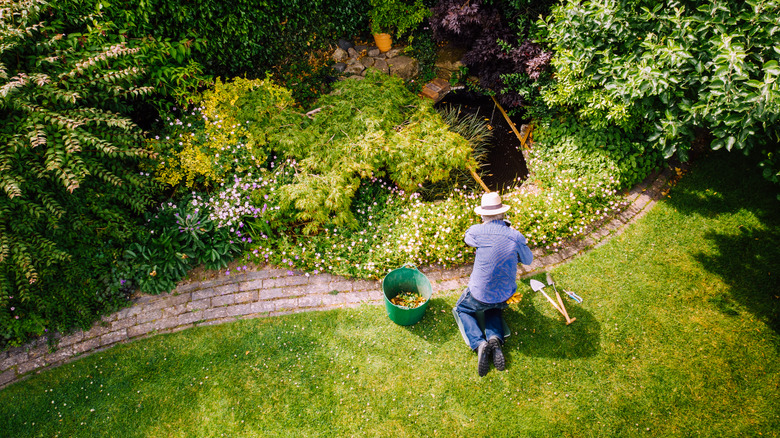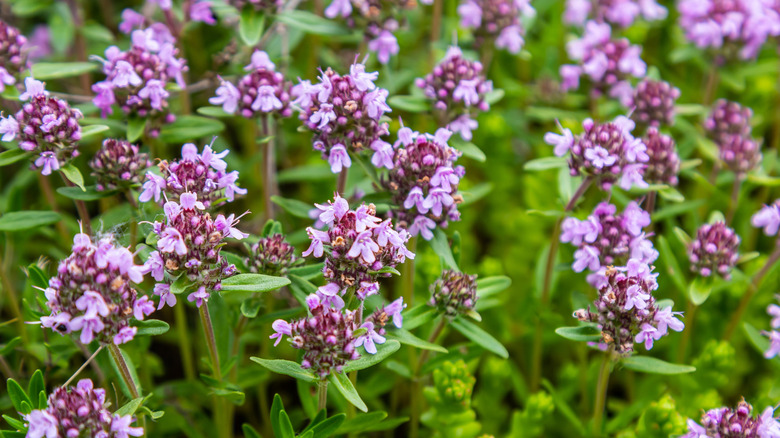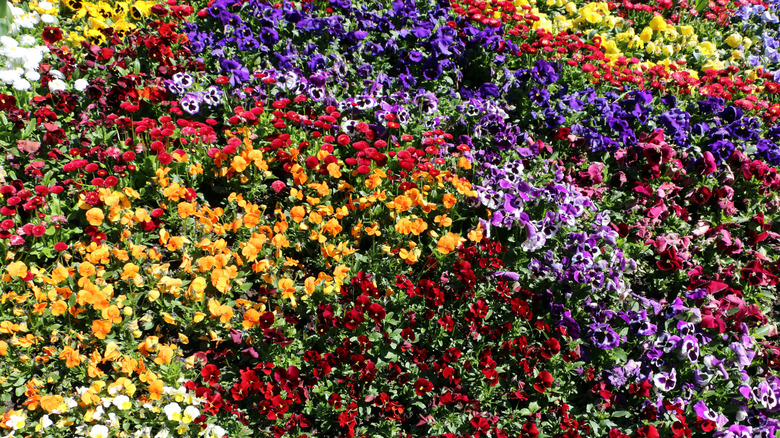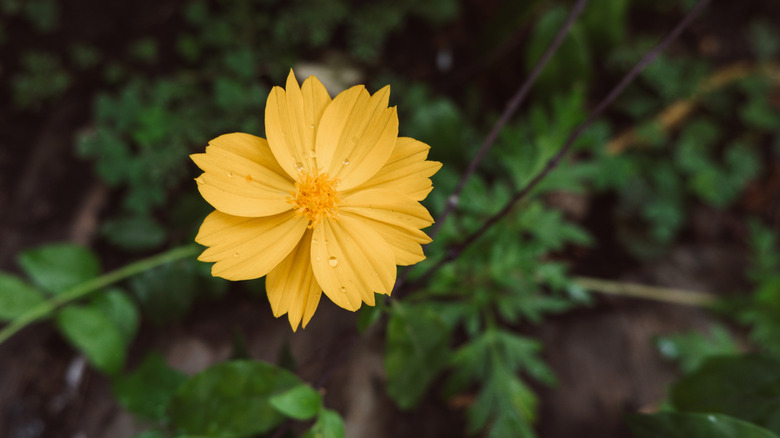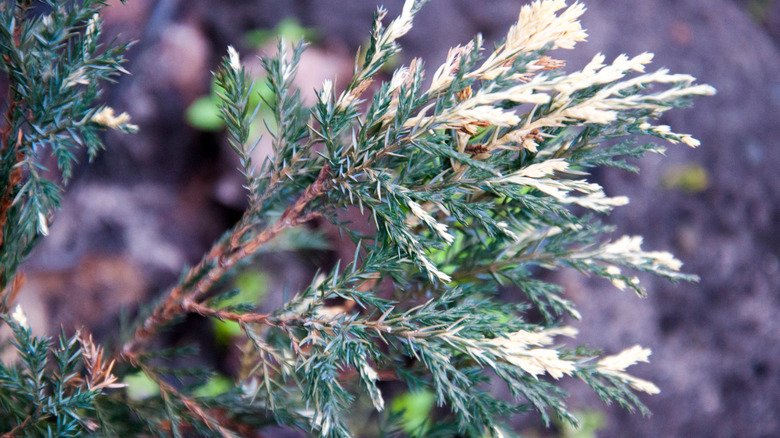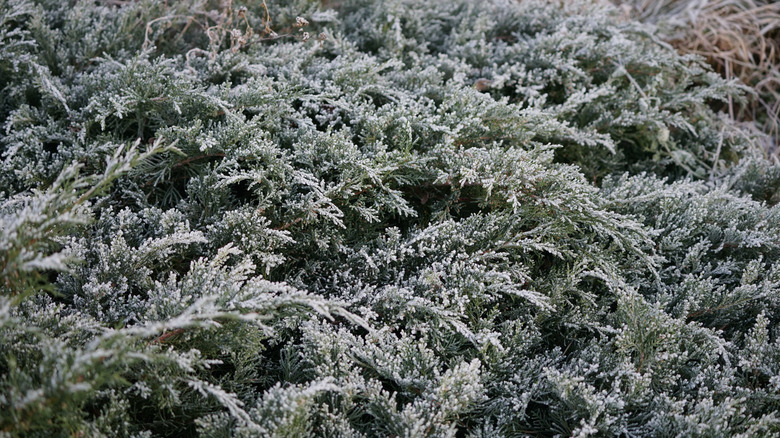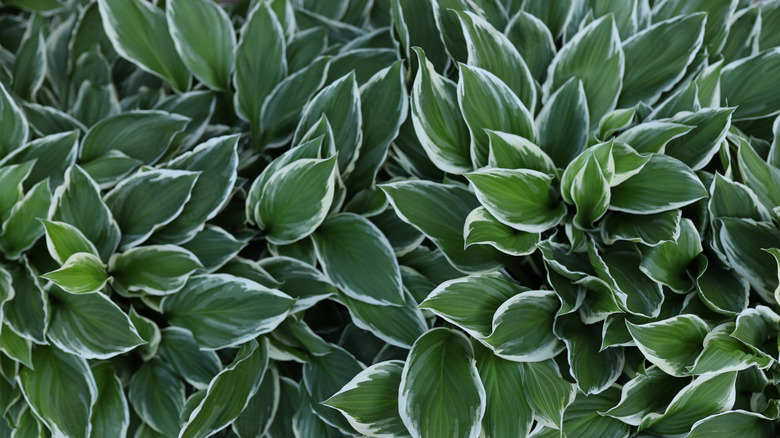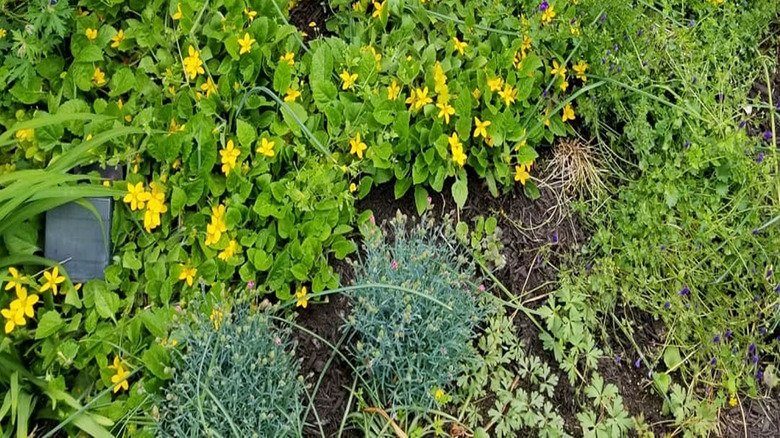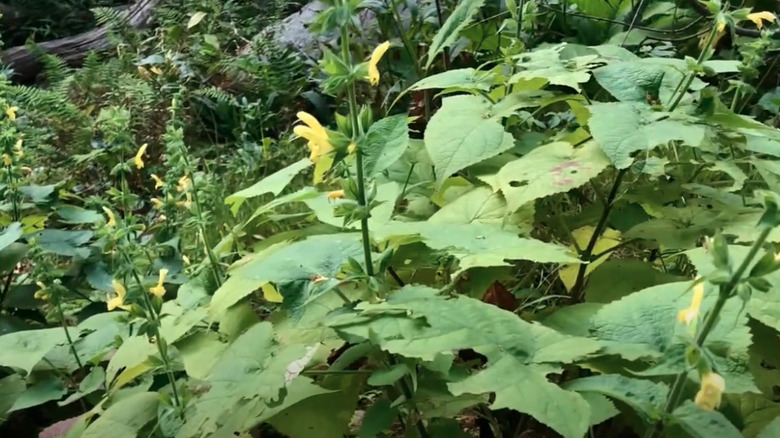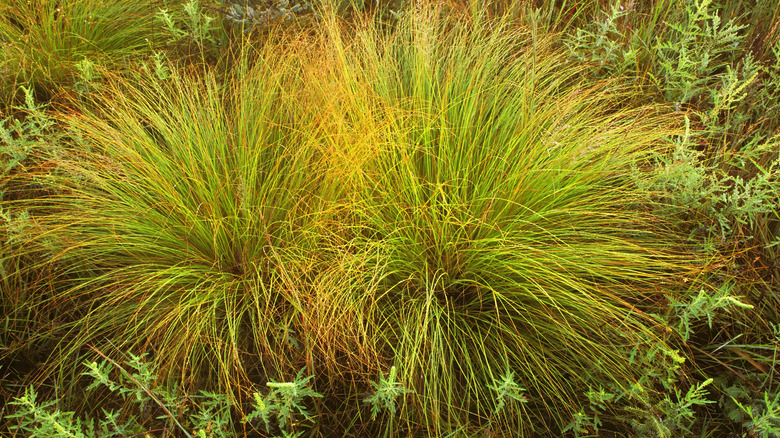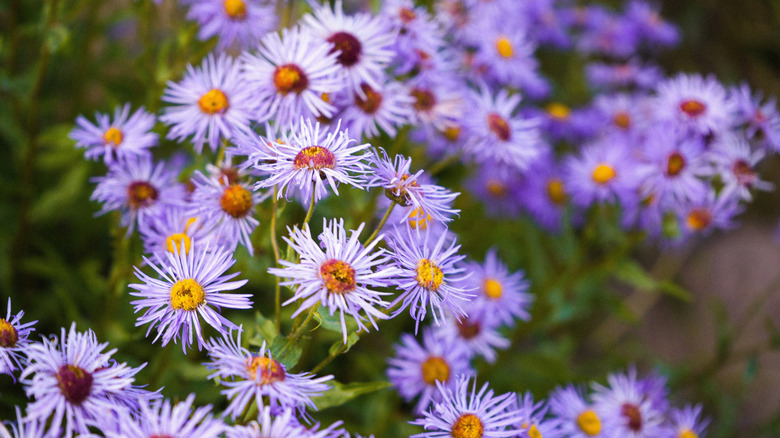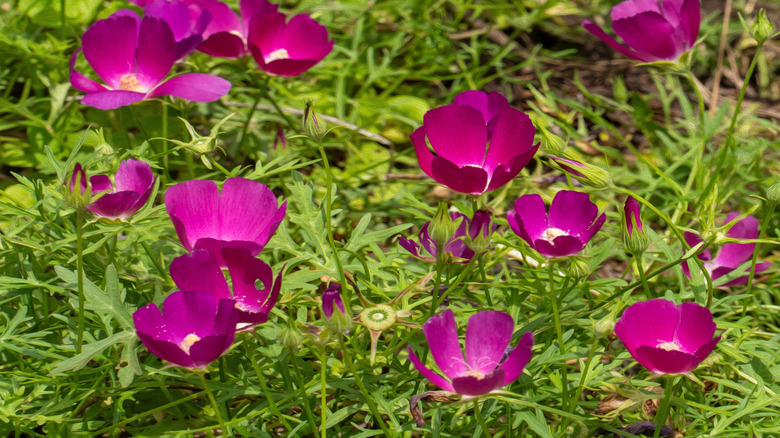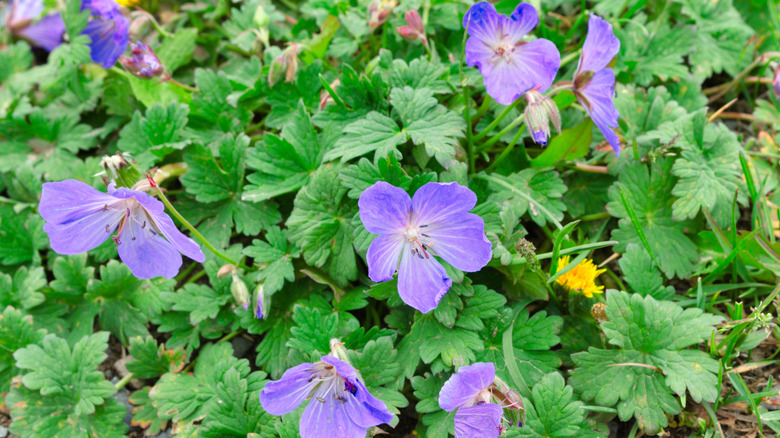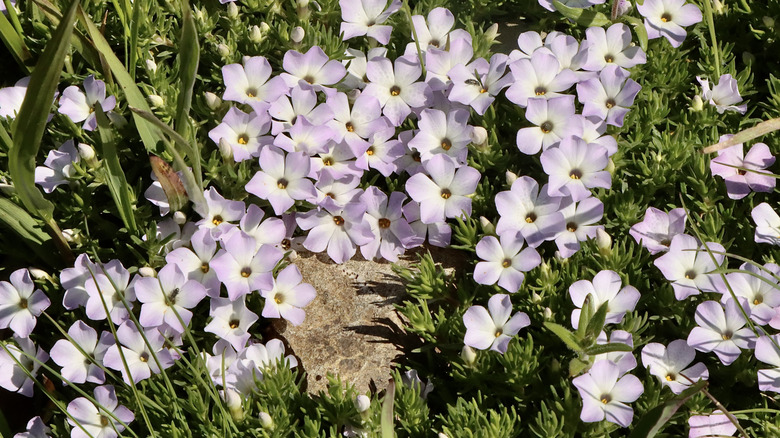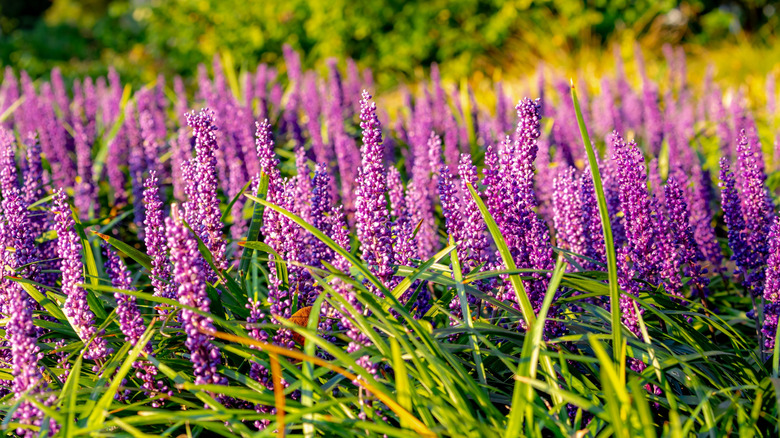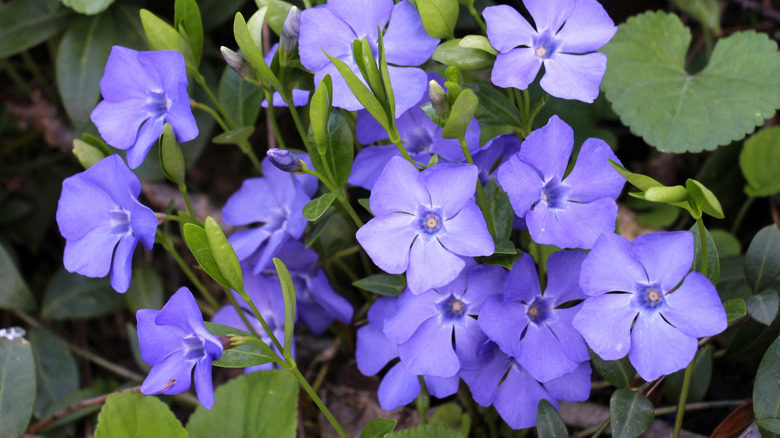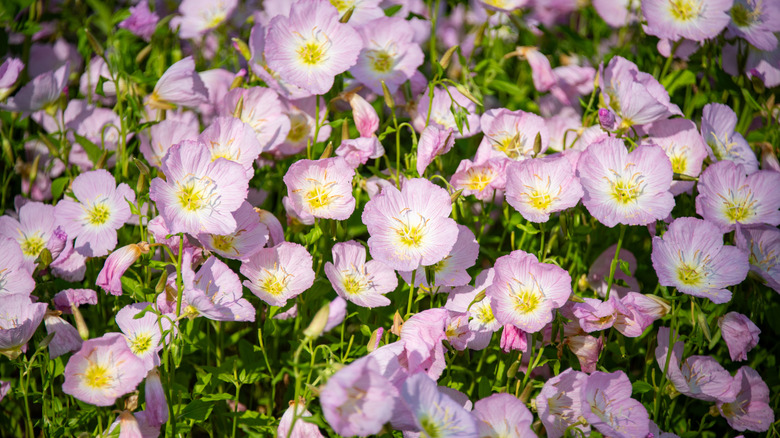16 Ground Covers To Plant In The Fall Before Cold Weather Rolls In
Fall might seem like a good time to start winding the gardening chores down, but for ground covers, it's one of the best seasons to plant. Cooler temperatures often mean less stress on new roots while the fall rains help keep soil evenly moist, letting the plants snuggle in comfortably right before winter. Once that last frost rolls around in spring, your ground covers are settled, secure, and ready to bloom, choking out weeds before they ever have a chance.
But planting in fall isn't just about timing; it's about giving your garden a nice layer of living insulation. These low-growing plants help protect your soil from winter erosion, buffer against temperature swings, and keep moisture where it's needed the most. That's why we've picked 16 of our favorite ground covers you can plant right in the fall. Whether it's for a much-needed last gasp of color, a hardy layer of soil protection, or giving your spring garden a great head start, you're sure to find one here that fits the bill.
Creeping thyme creates a long lasting mat of purple blooms
Creeping thyme (Thymus serpyllum) might be small, but it packs a punch when it comes to both beauty and hardiness. This fragrant, low-growing herb forms a dense mat of evergreen leaves that hug the ground year-round. By planting it in fall, you're giving those roots just enough time to anchor before winter dormancy kicks in. Once spring arrives, creeping thyme wakes up early and will spread quickly, turning into bursting carpets of purple or pink blooms that pollinators absolutely adore and naturally prevent weeds from growing. It's even hardy enough to handle snow cover, bouncing back stronger each year.
Creeping thyme hates having soggy feet, so plant it in a sunny spot with well-draining soil. Space young plants about 12 inches apart so they have room to spread, and add a thin layer of mulch. What's great about creeping thyme is its versatility; you can tuck it between stepping stones, along walkways, or at the edge of garden beds for a fragrant, flowering ground cover that doubles as a natural weed suppressant.
Wild violet can be planted or divided in fall to create a larger colony
Wild violets (Viola spp.) are some of those underappreciated garden gems that quietly earn their keep. Their heart-shaped leaves and different-colored blooms appear in the early spring, but love to be planted in the fall. As temperatures cool, the violet plants focus their energy on building strong rhizomes that steadily spread underground. So, by the time winter passes, you'll already have a healthy network of wild violets ready to burst into color. They're ridiculously resilient, too, handling salt, shade, and less-than-perfect soil with ease. But, if you've already got a bunch of wild violets planted, you're in luck; fall is the best time to divide them so that they're ready for spring.
To plant wild violets in the fall, choose a semi-shaded or lightly sunny spot with moist, but well-draining, soil. Space the clumps about a foot apart so they can spread naturally, then give them a good soaking in the morning to help settle the roots. Wild violet can grow aggressively, so give them plenty of space to spread out when you plant them. Don't wait too long, as you don't want the water to freeze over the plants at night.
Dwarf tickseed is hardy and keeps its foliage throughout winter
Dwarf tickseed (Coreopsis auriculata 'Nana') is the kind of low-maintenance ground cover that looks more complicated than it really is, making you look like some kind of Master Gardener. This compact, native perennial spreads by runners to form neat little colonies. And unlike many flowering plants, its rosettes of foliage will hang on throughout most of the cold months. Fall planting gives those runners enough time to take hold under the surface while the soil is still warm. By the time the warm weather rolls back in, you'll have tiny mounds of green ready to explode into those buttery yellow blooms.
When planting, space the plants about a foot apart to give the runners a little breathing room. Once the winter temps hit, just leave the foliage in place to act like an insulation blanket that protects the crown while keeping a little green in an otherwise dreary landscape.
The 'Andorra' creeping juniper turns from gray-green to purple in the winter
'Andorra' creeping juniper (Juniperus horizontalis 'Plumosa”) is one of those rare plants that manages to look good even in the bleakest part of winter. This hardy evergreen ground cover forms a dense, flat mat of soft, gray-green foliage that turns a gorgeous plum-purple as the temperatures drop. It's incredibly tough and adaptable, handling poor soil, wind, and drought without complaint. Cooler weather encourages new roots to establish before the ground freezes, letting it settle in comfortably for spring growth.
To plant, pick a sunny, well-draining spot, and space plants about two feet apart to give them room to spread naturally. When planting, skip adding heavy mulch, which can trap too much moisture. 'Andorra' creeping juniper practically takes care of itself; no trimming, no fuss, just reliable color that changes with the seasons. Just be careful not to plant this variety near other species, as it can grow aggressively.
The 'Wilton carpet' creeping juniper keeps its blue foliage all winter long
If you want a ground cover that looks like it came straight out of a winter fairytale, 'Wilton carpet' creeping juniper (Juniperus horizontalis 'Wiltonii') is it. Where other plants fade or die back, this low-growing ground cover keeps the color show going, blanketing the ground with blue-toned foliage. Like its cousin 'Andorra,' fall planting gives it time to anchor its roots before the freeze, setting it up to thrive come spring.
Plant 'Wilton carpet' in full sun and well-draining soil. Space each plant about two feet apart to allow them to spread evenly without crowding. Once they're settled in, these junipers need almost no maintenance and will creep gracefully over slopes, retaining walls, or bare ground. Just beware: like 'Andorra,' it can crowd out other plants.
Hostas are one of the first plants to develop foliage in the spring, making them great for fall planting
Hostas (Hosta spp.) may spend the winters looking kinda sad, but there's more going on than meets the eye. They spend most of their winters with the important stuff happening underground, which is helpful when you're one of the first foliage many will see after the last thaw. Hostas do great in fall planting because the cooler weather encourages stronger root development without the stress of summer sun or heat. When they're ready, they'll unfurl those big, beautiful leaves and suffocate young weeds before they even have a chance.
To plant hostas in fall you'll need a spot that receives some shade and has well-draining soil with good organic matter. To successfully care for hostas after that, just water well to get them locked into place and add a light layer of mulch once the ground begins to cool to protect their crowns in winter.
Goldenstars give one last bloom before winter frost sets in
Goldenstars (Chrysogonum repens), also known as "green-and-gold," are one of the few ground covers that can still surprise you with blooms right before winter sets in. Planting in autumn gives your goldenstars time to establish their shallow roots before the soil freezes, ensuring a fuller carpet of foliage and flowers the following spring. Even after the blooms fade, their semi-evergreen leaves keep the ground covered and neat through winter.
To plant in fall, pick a partially shaded spot with moist, well-draining soil that's enriched with organic matter. Space plants about a foot apart so they can spread naturally by stolons. Water regularly until the first frost to help the plants settle in, then let them do their thing. Once established, goldenstars are low-maintenance and so reliable that they're perfect for adding pops of color to sloped yards, a feat that's typically hard for shallow-rooted ground covers to do.
Yellow sage does best when planted in the fall
Yellow sage (Salvia koyamae) is one of those plants that will reward gardeners with a late-season show if they're willing to give just a bit of off-season effort. The soft yellow, two-lipped flowers appear from August through October in some areas, standing out against the plant's deep green, slightly fuzzy leaves. By getting its roots established before the ground freezes, it's ready to surge into growth once spring arrives and burst into bloom by late summer.
To plant in fall, choose a partly shaded area with well-draining soil that has lots of organic materials. Once established, yellow sage is fairly low-maintenance, requiring little more than occasional watering in dry spells. It's also deer-resistant and pollinator-friendly, so while it quietly rides out winter beneath the soil, it's setting the stage for a vibrant, low-stress display in the spring.
Plant prairie dropseed in the fall for a burst of blooms in the spring
For those who want something a little more dramatic, the prairie dropseed (Sporobolus heterolepis) is right up your alley. This slow-growing native perennial isn't a typical ground cover, but an ornamental grass that forms graceful, arching tufts of fine green blades. When planted in fall, prairie dropseed gets the perfect mix of cool temperatures and consistent moisture to start building its root system before winter sets in. By spring, it's ready to burst into full growth.
Prairie dropseed can thrive in anything from sandy soil to rocky conditions, but you'll get the best results planting it somewhere that's sunny and has well-draining soil. Once established, it's both drought-tolerant and deer-resistant. If you're interested in adding more native foliage to your garden, consider grouping several together as a soft border or in drifts because the tufts look especially striking when backlit by a golden autumn sunset.
Aromatic aster needs cold to germinate, so plant it right before the first frost
Aromatic aster (Symphyotrichum oblongifolium) is one of the last wildflowers to bloom before winter, and planting it in fall gives you a head start on next year's color. This hardy native perennial actually needs a bit of cold to germinate, so sowing it right before the first frost mimics nature's own cycle. Over winter, the seeds rest and stratify in the soil, then wake up in spring ready to grow strong, resilient roots. By late summer, the plant comes alive with daisy-like purple blooms that last well into November in some areas, offering some of the final food sources for pollinators before the cold sets in.
For best results, plant aromatic aster in full sun and well-draining soil. After flowering, leave the seed heads standing; they add texture through winter and provide a natural food source for birds. Also, once it's settled in, try crushing a leaf, and you'll understand its name; it releases a subtle, spicy fragrance that lingers in the air.
Poppy mallow grows best when planted in the fall
The Purple poppy mallow (Callirhoe involucrata), is known for its deep magenta blooms and is one of those rare flowering ground covers that looks delicate but is surprisingly hardy. This native wildflower thrives when planted in fall, as the cooler soil temperatures and winter chill help its seeds break dormancy naturally. By the time spring rolls around, those seeds have germinated and started forming a dense mat of trailing stems and lobed leaves that hug the ground and eventually burst into a blanket of cup-shaped flowers that bloom all summer long.
To plant poppy mallow in fall, rake the seeds lightly into loose, well-draining soil so they make good contact with the surface, but don't bury them too deeply. Choose a sunny location because this species loves heat once established, and leave it alone in the winter. Once it's settled, it'll spread gracefully without becoming invasive, adding a vibrant, low-growing splash of color that thrives with little attention.
Wild geranium makes a great ground cover when planted in the fall
Wild geranium (Geranium maculatum) is one of those dependable native perennials that quietly earns its rightful place in any garden. With its soft, lobed leaves and lavender-pink flowers, it brings a sort of wild-meadow charm that fits just as well in tidy borders as it does in naturalized spaces. Fall is an ideal time to plant it since cooler weather helps the rhizomes or seeds settle in and establish roots before winter. By the time spring arrives, the plants are ready to leaf out quickly and will send up clusters of delicate blooms that last well into early summer.
To plant wild geranium in fall, choose a spot with partial shade and moist, but well-draining, soil. If you're starting from seed, scatter them on the surface of prepared soil and lightly press them down rather than burying them. If planting divisions, space them about a foot apart so the clumps have room to fill in. Once established, wild geranium forms a low, leafy mat that suppresses weeds and offers soft texture throughout the growing season. It's low-maintenance, deer-resistant, and the perfect way to add gentle color to shady garden corners.
Sow mountain phlox in the fall to get the best spring blooms
Mountain phlox (Phlox austromontana) might not be the first plant you think of for ground cover, but once you see it in bloom, it's hard to forget. This low-growing perennial forms soft, branching mats that burst into clouds of delicate, five-petaled flowers. Planting it in fall gives the seeds the cold period they need to germinate naturally, ensuring stronger growth and an earlier, fuller display come spring.
To plant mountain phlox in fall, scatter seeds over loosened soil and lightly cover them with no more than a quarter inch of soil. Choose a sunny location with well-draining soil; these plants are adapted to lean, dry conditions and too much moisture can cause rot. Once established, mountain phlox is almost effortless to maintain, thriving in neglected corners and rewarding you with a burst of color just when the rest of the garden is waking up.
Propagating liriopes in autumn gives it time build strong roots
Liriope (Liriope muscari), sometimes called "lilyturf" or "monkey grass", is one of those plants that quietly does it all. This evergreen ground cover forms dense, grass-like clumps of arching green leaves that stay vibrant through most winters, then surprise you in late summer and fall with spikes of tiny lavender or white flowers. Fall planting gives your liriope time to build strong roots before the cold sets in, so it can hit the ground running when spring warmth returns. It's especially useful for edging walkways, filling slopes, adding a splash of color to dark corners of your yard, or introducing texture to shady beds where grass struggles.
To plant liriope in fall, choose a partly shaded area with fertile, well-draining soil. Space plants about a foot apart for quick coverage or farther apart if you prefer a looser look. Once planted, water deeply to help the roots establish, but avoid soggy soil. Once your first frost comes in, add a light layer of mulch for insulation.
Periwinkles can make excellent ground covers but can be invasive if you're not careful
Periwinkle (Vinca major and Vinca minor) is one of the most recognizable evergreen ground covers, known for its glossy green leaves and purplish-blue blooms that can sometimes appear as early as March. It spreads quickly, forming a dense carpet that suppresses weeds and stabilizes soil, which makes it ideal for slopes or shady patches under trees. Fall planting gives it time to root before the ground freezes, ensuring lots of growth once spring arrives. However, you may want to be cautious before growing periwinkle and check to see if it's recommended for your region as it's considered invasive in several U.S. states, particularly in the Northeast and Pacific Northwest.
To plant periwinkle in fall, pick a location with partial to full shade and well-draining soil. Space plants 12 to 18 inches apart to give them room to spread. Water thoroughly after planting and keep the soil lightly moist until winter sets in. Once established in regions where it's safe to grow periwinkle requires little maintenance, though occasional trimming may be needed to keep it in bounds.
Showy evening primrose lives up to its name if you plant it in the fall
Showy evening primrose (Oenothera speciosa) is one of those plants that looks delicate, but is hardy enough to handle whatever winter throws its way. It's a native ground cover that produces the most gorgeous pink flower clusters when planted in full sun, but can even handle a bit of shade if it has to. But what makes it particularly awesome is that its scented flowers come out at night, creating a flower show when other plants have closed up shop. Planting this ground cover in the fall gives it enough time to spread its stolons to create a dense mat that protects its roots during the tough winter months.
Showy evening primrose can live in most types of soil, but it behaves better if the soil is a little more rocky. If you're starting from seed, you can plant in the fall by simply raking the seeds into loose topsoil; just make sure the seeds are in contact with the soil so they can germinate. However, growing from seed can be tricky, so you may want to opt for a starter or mature plant instead. Give the ground a good morning soak after planting as it can't tolerate parched soil but you don't want to water too late to prevent excess water from evaporating instead of freezing.
